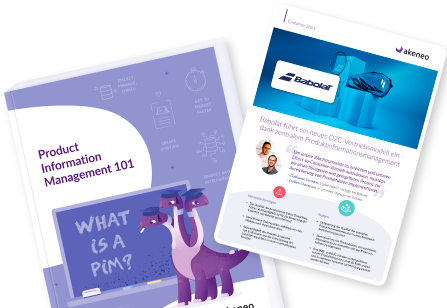Feb 09, 2023
7 min to read
PXM can act as the foundation for your omnichannel customer experiences, but how do you convince others in your organization to make the investment? Let's take a look at three important use cases for PXM, with concrete examples and KPIs you can take back to your team today.

They say it takes a village to raise a child. Well, you could say the same when it comes to implementing a Product Experience (PX strategy) and building a best-in-class Product Experience Management (PXM) practice.
Bringing together the right PIM team is the crucial first step for any successful PXM project, because implementing a Product Information Management (PIM) solution is a wide-ranging process that involves a wide swath of your organization. That means it’s critical to identify the key stakeholders and decision-makers in your organization early in the implementation process and help them understand the potential benefits of implementing PIM.
To help you garner support for PXM across your organization and become an evangelist for the power and potential of great product experiences, we’ve collected three tips to help you ensure your organization understands the value it can bring.
Improved process efficiency, a more manageable workload, and fewer manual tasks through automation are all good things that are made possible by a robust PIM. Decision-makers and executives, however, are typically more convinced by its impact on the bottom line.
They want to know how much the solution will cost, as well as what benefits the company could see if they do make this strategic investment. Namely, they need to understand the ROI, or return on investment, this solution holds. So, spread the word about the ROI of PIM by tracking key performance indicators, from improved conversion rates, reduced returns, improved time-to-market, lower enrichment costs, and even increases in average order volume.
Point to examples like Midland Scientific, a scientific instruments and lab equipment manufacturer, and an Akeneo customer. They were able to reduce the cost of product enrichment by 5 times — from $5/SKU to $1 SKU — and accelerate product catalog production speed by 50% after using Akeneo PIM to take control of their product information processes.
How far along is your organization on your journey towards compelling, omnichannel customer experiences?

Product Experience Management is the foundation of all great customer experiences — and product data is the stone that makes up that foundation. High-quality product information will ensure that your customers have great product experiences. Meanwhile, poor product experiences are often the result of inaccurate, inconsistent, or incomplete product data, bad digital assets, or poorly contextualized data.
These product information issues can reduce conversion rates, increase product return rates, negatively impact satisfaction with your brand, and reduce the likelihood of them shopping with you again. On the flip-side, they will become loyal shoppers of merchants who go out of their way to provide positive, compelling product experiences, especially unique experiences that utilize innovative technology. In fact, two-thirds have shoppers have abandoned a purchase to due a bad product experience, and just over half of all consumers said that they would be willing to pay at least 27% more for a product for a quality product experience.
Let’s take a look at Akeneo customer Turner Price. The foodservice wholesaler originally looked to Akeneo PIM to ensure that ingredients and allergen information is 100% accurate, correcting old and outdated information and was able to use our software to create a single source of truth for their product information. Since then, Turner Price has been able to triple their product range and cut enrichment times by 80%, leading to increased revenue and average order value.
The way an organization manages its product information is critical to business outcomes and its overall success. That means your team must focus on the effective management of your product information, even after you’ve initially spread the word about the importance of PXM.
Continue to emphasize the need to move from merely displaying product data across your channels to crafting product experiences that evoke emotion. Achieving real product experience management maturity is a crucial asset to driving growth.
Documenting and tracking your key KPIs is crucial to understanding the benefits from PXM and an investment in a PIM solution. But getting buy-in from your teams is equally important — that way, the technology is properly implemented, employed, and adopted to drive efficiency in your internal processes. Using the ideas listed here to evangelize the profession of PXM and the kind of results your enterprise can see will go a long way to help ensure adoption and success in your PXM journey!
Ready to learn more about how a PX strategy and PXM best practices can revolutionize your business? Reach out to an Akeneo expert today to get started, or check out our latest report conducted by Forrester Reporting, The Total Economic Impact of Akeneo’s PIM.
Sign up for our newsletter and stay ahead of the curve on everything you need to know about product information management, product experience management and how to unlock growth for your organization.
